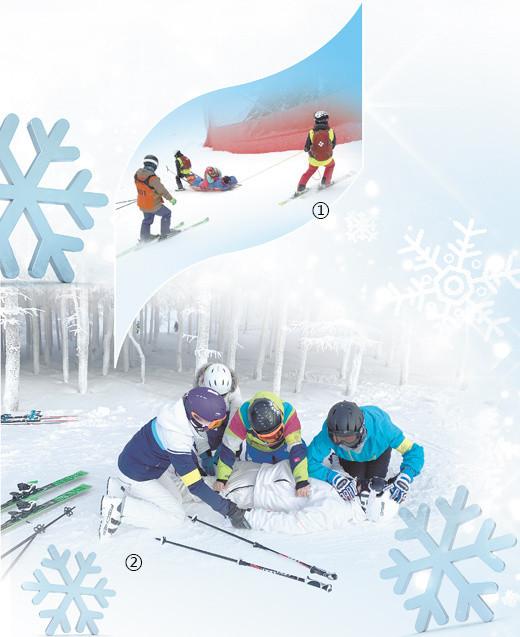
Pictured: The Winter Olympic Ski Medical Security "Dream Team" conducts a rescue drill. Courtesy of Bai Peng
On the track of the National Alpine Ski Center, an athlete suddenly fell and was seriously injured! Carrying a rescue bag weighing more than 10 kilograms, the ski doctor (also known as the ski track rescue doctor) Bai Peng rushed to the skis, judged the injury, bandaged and fixed, put the injured on the lifeboat and fixed it, and urgently transferred to the nearby athlete medical station...
This is a scene in the all-element emergency drill in the Yanqing Division of the 2022 Beijing Winter Olympics.
Alpine skiing is a sport that combines speed and skill. Athletes can reach a top speed of 140 kilometers per hour during the race. According to the International Snow Federation, once an athlete falls during a competition, medical workers must arrive at the scene within 4 minutes to quickly complete the assessment, first aid and transfer of the injured. However, before the Beijing Winter Olympics, China did not have alpine skiing tracks that met the standards of the Winter Olympics, and there was no special medical protection.
In January 2018, the Beijing Winter Olympics Organizing Committee held a skiing skills test for medical staff in Beijing and Hebei, and 232 medical staff from 45 hospitals showed their skills. Bai Peng won the first place in the men's group and joined more than 70 other people to form the "Dream Team" of the Winter Olympic Ski Medical Security, becoming the first generation of ski doctors in China.
Bai Peng is a post-80s doctor in the Department of Anesthesiology of Peking University Third Hospital and a veteran ski enthusiast. "At most, I 'soaked' in the snow field for more than 40 days in a winter, drove to the snow field on Fridays, and went home on Sundays." Over the years, he has skied all over the country's large and small ski areas, and has successively obtained the Canadian Ski Instructors Union Level II Instructor and china National Vocational Qualification Social Sports Instructor (Ski) Certificate.
Bai Peng is also a member of the Ski Association of the Three Hospitals of Beijing Medical College. Under the leadership of Zhou Fang, executive director of Yanqing Hospital of the Third Hospital of Beijing Medical University, the association has organized many ski on-site medical rescue lectures and snow rescue drills, and held the first winter sports injury treatment seminar. Over time, the Ski Association of the Three Hospitals of Beijing Medical College became famous, and some of the infirmaries of the snow parks encountered difficult problems and often asked them for help.
At first, Bai Peng was very confident in being a good ski doctor, but as soon as he entered the training process, various difficulties ensued.
Skiing pays attention to balance, stepping on skis, carrying more than 10 kilograms of rescue kits and AED (automatic external defibrillator), carrying drug injections in his arms, it is not easy to maintain balance, falls and injuries are common, several team members have suffered spine, ankle and other parts of the fracture and joint ligament injuries. Once, the temperature of Chongli's alpine snow field dropped to minus 37 degrees Celsius, and a 9-degree wind blew. The wind swept through the snow, and the temperature felt at minus 60 degrees Celsius. After 8 hours of training, despite the antifreeze sticker, Bai Peng's cheeks were still frozen red and swollen, and the toes of one of the team members were even frozen black.
First aid is harder on the track. The main track of Xiaohaituoshan is 2950 meters long, with a vertical drop of 894 meters, cold weather, steep terrain and changeable wind direction, which brings great challenges to medical rescue work. In the snow field of minus 20 to 30 degrees Celsius, the team members knelt on the snow to practice cardiopulmonary resuscitation, lying on the steep slope or even lying on their sides to try endotracheal intubation, freezing their hands and feet numb and their whole body cold.
After the high-intensity snow training, the team members dragged their heavy legs back to the station, and the intense night study began. Chest trauma rescue program, head trauma rescue process, emergency airway management for patients with sports trauma... The team members deduced various possible emergencies and continuously optimized the first aid plan.
The treatment of disabled athletes, whether it is sports equipment, injury methods or injury examination and treatment, has a special nature. "For example, how to deal with sitting ski equipment used by athletes with lower limb disabilities is completely inexperienced." Bai Peng introduced that after repeated communication with the Chinese disabled alpine ski team, the team members gradually explored a set of effective treatment methods and processes to deal with the injuries in the track of disabled alpine skiers.
"I didn't expect a hobby to come in handy, and it was worth it no matter how tired I was." Bai Peng said proudly. Every snow season, in addition to intensive training, he also tries his best to take time to go to the snow field to practice, and sometimes even his legs will grind blood bubbles. In September 2021, the "Dream Team" selected nearly 10 core team members to participate in rope rescue training, and Bai Peng completed all the courses despite his wrist injury and with the help of braces.
After three snow seasons, the "Dream Team" has become a medical security team recognized by the International Snow Federation, and successfully completed the medical security tasks of the 14th National Winter Games in 2020 and the "Meet in Beijing" series of winter sports event test activities in 2021. For the upcoming Beijing Winter Olympics, Bai Peng is full of expectations: "We have made full preparations, but the biggest wish is that athletes can be safe and achieve excellent results on the field. ”
People's Daily ( 2022-01-26 11th edition)